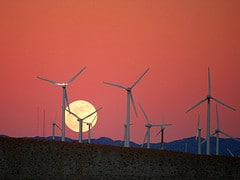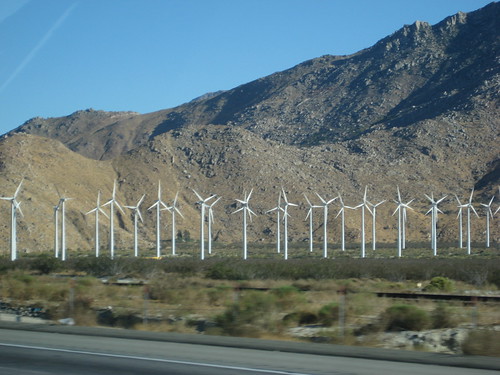
Wind Energy: 8 Ways to Collect It
Wind power is becoming an ever-increasingly popular way to collect energy. Just last year the wind power industry grew an impressive 31% despite the economy. It is now estimated to be a $63 billion/year industry, employing around half a million workers worldwide.
However, like solar farms, there is only a limited amount of land that can be used for wind farms before we completely remove the beauty and necessity of Mother Nature in favor of renewable energy. So, what can be done?
Luckily people continue to imagine and design new ways to capitalize on the power of the wind. Let’s take a look at some of the “standard” and not-so-standard ideas for catching the power of the wind:
First we start off with some traditional wind turbines like the kind you find on your way to Palm Springs, CA. These particular turbines are part of one of the three major wind farms that produce approximately 95% of California’s wind generating capacity. The large turbines are designed to take the motion of the wind, turn it into mechanical energy which is then converted into electrical energy.
One major downfall with this type of wind energy is that the average wind farm can require up to 17 acres of land to produce one megawatt of electricity. So wind farm land resources are limited.
This “highway turbine” was thought up by an Arizona State University student. The turbines are designed to pick up wind generated from passing cars. Since the turbines are placed over the freeway, cars passing underneath will be traveling 65-70 mph on average which will allow each turbine to produce approx 9.6 kWh of energy annually. That’s enough to light up a small apartment or help power the street lights on the freeway.
The energy storing wind dam is a “compact” solution to wind turbines. Wind dams are designed so they can be added on to an existing dam or hydro-power station. Attaching it to an existing hydro-power station could also allow it to help boost energy during peak times and store energy during off peak times.
Another one of the great things about wind dams is the turbines are closely stacked together so the whole dam operates as a single turbine essentially. And rather than needing a large piece of land in order to place individual turbines, the wind dam puts multiple turbines all in one compact area.

Promoted as the world’s first “high altitude wind turbine”, the Magenn Air Rotor System (or M.A.R.S. for short) is designed to fly high above the rest. It labels itself as being bird- and bat-friendly, low cost and able to tap into more reliable winds due to its high altitude. The turbines are able to be inflated and deployed almost anywhere. They are also made of a material that allows them to quickly be deflated, packed up, moved and re-inflated without the need for towers or heavy equipment. Take a look at this short video to give you an idea of how the air rotor system works:
For those who don’t want to go up with their wind energy collection, they can always go out…out to sea that is. Offshore wind farms are getting more attention these days as companies look for wind catching solutions to solve the “lack of open land” problem.

Of course, there are also groups that oppose having wind farms off their shoreline. But what’s interesting, is they aren’t necessarily opposing the off-shore wind farms all together, they just believe there are places better suited for them, rather than Nantucket Sound. What do you think?
I like these turbines in particular as they are designed to be aesthetic (not an eye-sore). They also use the wind they are generating to power the street lights they are attached to. It’s similar to the “highway turbine”, but this wind powered light seems to have a broader use and is, in my personal opinion, a better option.
The Helix Wind Turbine (a vertical axis wind turbine) is a simple idea, especially when you don’t have a lot of room or want a huge spinning turbine on your property. Designed mainly for residential and small commercial properties, the Helix is also a good choice for low wind areas as its design is sculptured to allow maximum access of the blades.
Now, these aren’t all nor even necessarily the best ideas on how to capitalize on wind energy. And, if you’re interested you can check out thewindpower.com (the wind turbines and wind farms database).
But hopefully you get the idea that there are many different ideas out there on how to generate energy through wind power. What about you? Do you have any creative ideas on how to capture the power of wind?
25 Comments
-
-
-
-
-
ty
I did some work a while back for buildingturbines.com which took an idea like this and is in the final stages of putting the product on the market. It uses similar wind collection methods above but on top of buildings.
Even a few stories up and there is already a large amount of wind able to be collected, and just looking around my local city you see all the possible places they could be placed. They are further improved by taking advantage of wind shear on the sides of buildings etc….
my point being the energy is out there, but these ideas need to be put into practice
-
Micheal Warren
Have you seen the page delezer.net its a nice energy site, but is more scientific. Many just as nice as this blog.
-
Rob
Small wind power can be interesting stuff. Large wind power is turning into a nightmare in Maine. Perhaps you weren’t aware of this.
I have to take issue right off the bat with your opening statement, “Wind power is becoming an ever-increasingly popular way to collect energy.” Here in Maine, wind turbines are become increasingly UNPOPULAR because of lax oversight stemming from expedited lawmaking and excessive, uncontrolled whining and thumping noise that drives nearby residents to medical attention from sleep disturbance and stress. Wind is an unreliable fuel source, a grid power engineer’s nightmare. The economic shell game has people upset as well. Wind energy is *four times* as expensive as the equivalent energy savings using CFLs. In Maine, most regular people agree that “stimulus” funds ought to be used for energy efficiency improvements by local contractors, not payments to overseas companies and fat cat holding company owners. There are few permanent jobs in Maine created by wind turbines and Maine’s beautiful landscape and natural quiet is being ruined. Lawsuits have been launched. Industrial grid-scale wind energy is not a pretty picture in Maine and it is going to get worse. Powerful political and corporate forces are working to push through *thousands* more wind turbines over hundreds of miles of shoreline and mountains. Vacationland is turning into WindTurbineLand.
The lessons emerging in Maine from actual measurements and testimony is that large scale wind is, expensive, unreliable, intrusive over a reach of miles and can fit into the quiet natural environment in Maine ONLY if it can be made silent. However- that is impossible because of the blade design currently being used.
Maybe small wind power can be made silent. For the moment, Maine is being buried by Big Wind.
-
-
TnFlash
Great Information! I am a big fan of Wind Turbines. For the home handy man, they are easy to build and install. The vertical axis wind turbine can require considerably less wind and are quiet. Thanks for posting this information!
-
Jaret
The highway turbines sound like a great idea but are actually a terrible idea because they would decrease the mileage that all the passing cars would get.
Picture this: You are walking through one of those ball pits that kids play in in places like McDonald’s. There is a certain amount of resistance that the balls cause, so as you walk you have to push against the balls.
Now picture that there is a giant mill in the pit. As you walk, the balls push against the mill and cause it to turn. You have to work that much harder to push your way through the balls as you walk because the mill is causing extra resistance against the balls that you are walking through. You push against the balls, and the balls in turn push against the mill. You would be spending extra gas to get back a small amount of electricity.
The best idea I’ve heard lately is to fly giant kites from container and dry bulk ships to save fuel. This was first tested a couple years ago with some success.
-
Jean Luc Reseau
Great post. An energy storing wind dam is excellent because it allows closely stacked turbines due to the separation attained by the ducts minimising interference. That means there is a greater turbine density or wind collection area i.e. the wind sees the wind dam as one large turbine.
-
wind turbine
that’s really a fantastic post ! added to my favourite blogs list.. I have been reading your blog last couple of weeks and enjoy every bit. Thanks.
-
John
I am in favor of the wind turbines further. There are many opportunities where they are committed, such as at sea. Since we had plenty of space and it usually blows a strong wind. The idea of street lighting does not sound bad, but can not be realized, but not enough wind blowing on the ground.
-
Bia Weiss
One of the greatest advantages of Wind Energy is that it is ample. Wind Energy is also advantageous over traditional methods of creating energy, in the sense that it is getting cheaper and cheaper to produce wind energy. It may soon be the cheapest way to produce energy on a large scale.
-
Eli
do we not need energy efficient ways to power the car? we already heve plenty of way to make cheap efficient energy for household items. Right now people are working on electric powered cars and i was wondering if a wind powered alternator/energy creator would be a probable thing, on the top of the car wind zooms over, so make a little slot and have a helix type turbine in the trunk that would help power the electric car. sure toyota has a hybrid but Teslamotors has a fully electric sports car…would this turbine thing not act as a great intermediate to make the charge last longer?
-
Pat Cardiff
Hey folks,
Love your site, and alternatives to collecting wind.
How about wind socks? Like the dam collector, but more of them?
Also, why do large wind turbines have to be so far apart? They would save space and perhaps aesthetics keeping them together, and it doesn’t seem to be too much of an issue making sure they don’t hit each other. Just asking.
Thanks,
Pat
-
sairam
very helpful to the students thank u
-
Tina
Yea, they can also make some noise too, but it’s not that bad if you’re not too up close to it. The way I think is that is a small price to pay if we can generate a clean and reliable source of energy. I don’t think there is a way to make it safe for birds from flying into it.
-
L.T.
Yay
-
-
L.T.
Thanks for the info for my project





Stephanie
Love the creative highway turbines! Those are super cool!